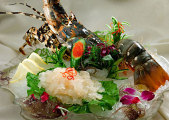The south South China (Guangdong, Hainan) is in the tropical and subtropical zones, with rivers, lakes, and a higher rainfall. Because of the rich resources brought by these climate and landscape factors, Southern Chinese food is characterized by the staggering variety of the ingredients used, and is widely regarded as the country’s best. In addition to produce, meats and seafood, Cantonese cuisine is known for its sometime use of ‘exotic’ ingredients. A | 
|
famous proverb illustrates the variety of Cantonese food: "anything that walks, swims, crawls, or flies with its back to Heaven is edible." However, these exotic foods are not eaten that often. Guangdong food are often exaggerated and magnified by these sayings often due to the lack of understanding in foreign culinary traditions in the Western world. Guangdong cuisine stresses freshness of ingredients and corrects cooking method. Ingredients are usually prepared with a light touch, just enough cooking and seasoning to keep the original color of the material and the natural flavors of the foods. There are countless Cantonese cooking methods, steaming, stir-frying, shallow frying; double boiling, braising and deep-frying are the most popular cooking methods. The traditional Guangdong cuisine emphasizes seafood, especially various kinds of steamed fish and shellfish. Pork and duck in whole are glazed with mixtures of soy sauce, peanut oil, ginger, onion, sugar, wine, and roasted to a beautiful reddish gold. Dishes are almost always served with freshly steam rice, since rice is the staple crop of South China.
Most Chinese restaurants in western countries serve the Cantonese food, or its derivatives (partly because of the large emigration from this region in the early days). Guangdong cuisine has been heavily influenced by foreign cooking cultures.
|